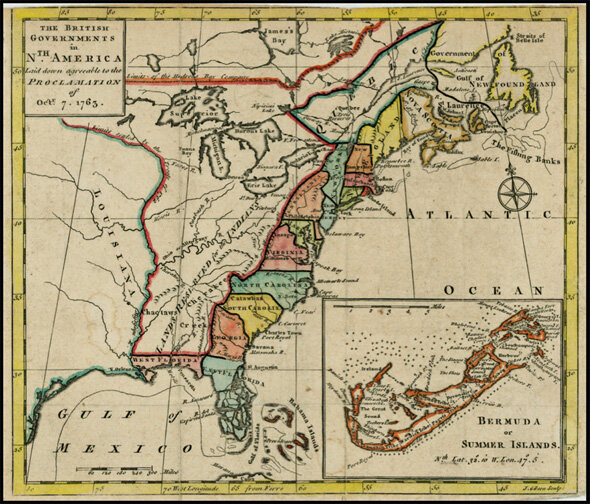Treaty of Lochaber, 1770
Royal Agents negotiated with native tribes for their concession of lands for settlement by the expanding population of colonists.
Undoubtedly, America was occupied by other people before it was claimed by later arrivals who also wanted it.
Some of America’s earliest westward movement began when too many people were crowded along the coast. And that westward movement continued during the colonial period leading up to the Revolution. Even when the population of the American colonies was only 2.2 million in 1770, many among those seeming few, by comparison to today’s population, wanted access to what they saw as the open lands beyond where then-current settlements extended.
After the French and Indian War (1754-1763), known everywhere outside the American colonies as the Seven Years War, King George III wanted to separate two groups of his subjects—“his children”—in America. “Indian wars” were good for no one. At age 24 and after being the monarch only since October 1760, the King issued the Proclamation of 1763 on October 7. He separated the two respective regions by the crest of the Appalachian Mountains, with his “native subjects” given lands whose waters flowed westward and his “colonial subjects” restricted to lands draining to the Atlantic. And that demarcation held for some time, as land hungry settlers pushed into the lands east of the mountains ceded by native tribes. But adventurous sorts—hunters and land speculators—had already gotten a view of the bounteous and rich wilderness across the mountains. Their appetites for more land where quickly whetted.
In November 1768, the Treaty of Fort Stanwix secured an agreement with the Six Nations of the Iroquois Confederacy to open lands in the Northern Appalachians for settlement. The Treaty of Hard Labor, October 1768, was a companion agreement with Cherokees farther south. But even that agreement which ceded lands in today’s West Virginia and western Virginia was confusing, so it was clarified by the 1770 Treaty of Lochaber.
“John Stuart at Treaty of Lochaber” represented by Tom Turner portraying William Blount at Treaty of the Holston, 1791. Reenactment at Fort James White, Knoxville, TN, 2009.
The Treaty of Lochaber was signed that October by John Stuart, superintendent of Indian affairs for the Southern district. He had served in that role for almost nine years, since January 1762. The treaty was held on the Lochaber plantation of Alexander Cameron, a deputy superintendent to Stuart. For his service during the French and Indian War, Cameron was awarded 2,600 acres in western South Carolina in Abbeville County in the Little River basin along Penny Creek. Cameron, a Scotsman, took the name Lochaber for his plantation from a region of his homeland. Cameron had served during the war years in South Carolina and Georgia, sometimes at Fort Prince George in the uplands of South Carolina. It was there John Stuart first observed his easy manner of engagement with the Cherokees. After the war, Cameron traded with and got to know well the Cherokee people; he married a Cherokee woman. As an appellation of affection, they called him “Scotchie.”
This “John Stuart” is not the same John Stuart (Stewart), brother-in-law of Daniel Boone, mentioned in “The Initials JS”.
Although the treaty was held in South Carolina, the agreement addressed land in Virginia. The Cherokees agreed to move the boundaries of their claims farther west from those drawn in the Treaty of Hard Labor. This new agreement included lands in today’s Kentucky east of the Kentucky River and south of the Ohio River. It also included most of the land in today’s western West Virginia. These were lands already claimed by the Greenbrier Company and the Loyal Land Company, respectively championed by Andrew Lewis and Dr. Thomas Walker, members of Virginia’s House of Burgesses.
“Attakullakulla” portrayed by
Rob Rambo.
During the later marking of the boundary, Cherokee headman Attakullakulla “pitied” the settlers who had already moved into a region in today’s extreme northeast Tennessee, north of the South Fork of the Holston River. Attakullakulla agreed to adjust the boundary to accommodate these “Virginians.” Although the Treaty of Lochaber addressed the claims of the Cherokee to these lands in Virginia, it did not address the claims of the Shawnees to these ceded lands. Thus was the stage set for conflicts in the coming years regarding America’s westward movement into Kentucky, soon to be called, “the bloody ground.” •
Attakullakulla, Alexander Cameron, and John Stuart figure as well into later episodes of our becoming America.




